
dLLM-RL
TraceRL: Revolutionizing Reinforcement Learning Framework for Diffusion Large Language Models
Stars: 222
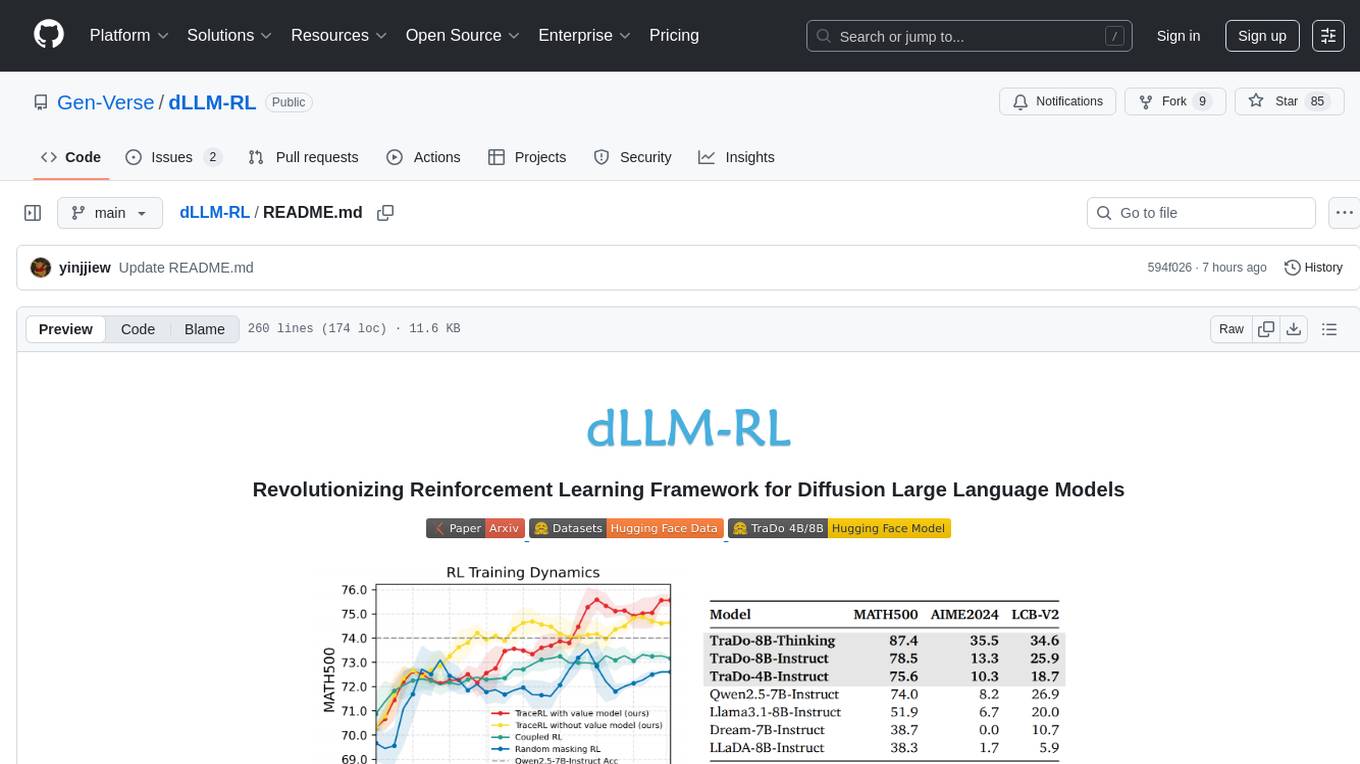
dLLM-RL is a revolutionary reinforcement learning framework designed for Diffusion Large Language Models. It supports various models with diverse structures, offers inference acceleration, RL training capabilities, and SFT functionalities. The tool introduces TraceRL for trajectory-aware RL and diffusion-based value models for optimization stability. Users can download and try models like TraDo-4B-Instruct and TraDo-8B-Instruct. The tool also provides support for multi-node setups and easy building of reinforcement learning methods. Additionally, it offers supervised fine-tuning strategies for different models and tasks.
README:
- Model Support: TraDo, SDAR, Dream, LLaDA, MMaDA, Diffu-Coder We support models with diverse structures, including full attention models, adapted models, and block attention models.
- Inference Acceleration: improved KV-cache, jetengine (based on nano-vllm), different sampling strategies, support multi-nodes, easy to build your own accelerated inference methods
- RL Training: TraceRL (support diffusion value model), coupled RL, random masking RL, accelerated sampling, including Math, coding, and general RL tasks, support multi-nodes, easy to build your reinforcement learning methods across diverse settings
- SFT: Block SFT, semi-AR SFT, random masking SFT, support multi-nodes and long-CoT finetune
We propose TraceRL, a trajectory-aware reinforcement learning method for diffusion language models, which demonstrates the best performance among RL approaches for DLMs. We also introduce a diffusion-based value model that reduces variance and improves stability during optimization.
Based on TraceRL, we derive a series of diffusion language models, TraDo, which achieve state-of-the-art performance on math and coding reasoning tasks. TraDo-4B-Instruct and TraDo-8B-Instruct are trained solely with TraceRL, while the first long-CoT diffusion language model, TraDo-8B-Thinking, is obtained through a combination of TraceRL and long-CoT data SFT. TraDo models challenge AR models with strong empirical results, as shown in the following table.
We can download and try our model:
from transformers import AutoModelForCausalLM, AutoTokenizer
from generate import block_diffusion_generate
model_name = "Gen-Verse/TraDo-8B-Instruct"
model = AutoModelForCausalLM.from_pretrained(
model_name, trust_remote_code=True, torch_dtype="float16", device_map="cuda"
)
tokenizer = AutoTokenizer.from_pretrained(model_name, trust_remote_code=True)
prompt = "What's the solution of x^2 - 2x + 1 = 0\nPlease reason step by step, and put your final answer within \\boxed{}.\n"
messages = [{"role": "user", "content": prompt}]
text = tokenizer.apply_chat_template(messages, tokenize=False, add_generation_prompt=True)
tokens = tokenizer.batch_encode_plus([text], return_tensors='pt', padding=True, truncation=True, max_length=200)
tokens = {k: v.to(model.device) for k, v in tokens.items()}
output_ids = block_diffusion_generate(
model,
prompt=tokens,
mask_id=151669,
gen_length=200,
block_length=4, denoising_steps=4,
temperature=1.0, top_k=0, top_p=1.0,
remasking_strategy="low_confidence_dynamic",
confidence_threshold=0.9
)
output_text = tokenizer.decode(output_ids[0], skip_special_tokens=False)
cleaned_text = output_text.replace('<|MASK|>', '').replace('<|endoftext|>', '')
print(cleaned_text)
- [2025-09-08] 🔥 We release our models, TraDo-4B-Instruct and TraDo-8B-Instruct, and the long-CoT diffusion language model TraDo-8B-Thinking.
- [2025-09-08] 🔥 We release inference and training (SFT and RL) code compatible with a wide range of diffusion language models, including TraDo, SDAR, Dream, LLaDA, MMaDA, and Diffu-Coder.
conda create --name dllm-rl python=3.10
source activate dllm-rl
pip install torch==2.6.0
pip install --no-cache-dir \
https://github.com/Dao-AILab/flash-attention/releases/download/v2.7.4.post1/\
flash_attn-2.7.4.post1+cu12torch2.6cxx11abiFALSE-cp310-cp310-linux_x86_64.whl
pip install -r requirements.txtYou can navigate to ./data to download datasets for evaluation and training, for example as follows. In that directory, you will also find detailed instructions on how to modify your own dataset.
cd data
python download_data.py --dataset MATH500
python download_data.py --dataset MATH_train
cd ..After downloading the data, you are almost ready to evaluate or train diffusion language models. The only remaining step is to select (or create) a config file in ./configs that corresponds to your project, and then use the following commands. Details on how to select and modify (or create) a config file are provided in ./configs.
After downloading the data, take TraDo models as an example. You can set the configurations in configs/trado_eval.yaml (see instructions and details in ./configs) and run the following commands to perform inference with different sampling strategies.
python eval.py config=configs/trado_eval.yaml
# python eval.py config=configs/trado_longcot_eval.yaml
# python eval.py config=configs/sdar_eval.yaml
# python eval.py config=configs/dream_eval.yaml
# python eval.py config=configs/llada_eval.yaml
# see details in ./configsUse trado_eval.yaml for TraDo models' inference, sdar_eval.yaml for SDAR, dream_eval.yaml for Dream and Diffu-Coder, and llada_eval.yaml for LLaDA and MMaDA. Instructions on how to set the configurations are provided in the corresponding configuration files.
We support both general tasks and coding tasks (including automated execution of code) in evaluation.
There are two main sampling methods you can choose:
Static Sampling: unmask fixed number of tokens each time
Dynamic Sampling: unmask tokens based on a chosen threshold, faster than static
To have a look how diffusion language models sample, open ./sample/trace.viewer.html in your browser, or generate trajectory by your self with ./sample/get_trace_viewer.py.
You can also perform inference across multiple nodes using multinode_eval.py with the same configuration files, with only minor modifications as instructed in the configuration files.
In multi-node setup, the first node controls the others. You can run
python multinode_eval.py config=configs/dream_multinode_eval.yaml on the first node to eval, or submit the following as the entry command for a job:
if [[ ${MLP_ROLE_INDEX:-0} -eq 0 ]]; then
python multinode_eval.py config=configs/dream_multinode_eval.yaml
else
exec tail -f /dev/null
fi
# python multinode_eval.py config=configs/trado_longcot_multinode_eval.yaml
# python multinode_eval.py config=configs/llada_multinode_eval.yaml
# ...After downloading the data and model and setting the configuration, you can start reinforcement learning simply with:
python rl.py config=configs/rl_trado.yaml
# python rl.py config=configs/rl_sdar.yaml
# python rl.py config=configs/rl_dream.yaml
# python rl.py config=configs/rl_llada.yaml
# python rl.py config=configs/rl_mmada.yaml
# see details in ./configsWe support TraceRL (optionally with a diffusion-based value model), Coupled RL, and random masking RL across different diffusion language models. The sampling process has been accelerated in all cases by KV-cache.
TraceRL: We optimize the policy based on how it generates sequences. For block-attention models, training can be performed efficiently thanks to block attention. For full-attention models, we introduce a shrinkage parameter, s, that aggregates every s neighboring steps to accelerate training. We also provide a choice of value models for TraceRL, which we find can reduce variance and improve training stability, enabling the use of larger learning rates or fewer gradient accumulation steps more reliably than without using value model.
Random Masking RL: The sampled data are randomly masked and used as training data in RL with a PPO-like objective.
Coupled RL: For each sampled random masking setting, Coupled RL additionally introduces its complement, serving as an extra data sample for training.
We also support a multi-node RL framework; you can submit the following as the entry command:
if [[ ${MLP_ROLE_INDEX:-0} -eq 0 ]]; then
python multinode_rl.py config=configs/multinode_rl_trado.yaml
else
exec tail -f /dev/null
fi
# python multinode_rl.py config=configs/multinode_rl_sdar.yaml
# python multinode_rl.py config=configs/multinode_rl_dream.yaml
# python multinode_rl.py config=configs/multinode_rl_llada.yaml
# python multinode_rl.py config=configs/multinode_rl_mmada.yamlAfter downloading the data and setting the configurations, you can start supervised fine-tuning with:
accelerate launch \
--num_machines 1 \
--machine_rank 0 \
--main_process_ip 127.0.0.1 \
--main_process_port 8888 \
--config_file accelerate_configs/1_node_8_gpus_deepspeed_zero3.yaml \
train/sft_trado.py \
config=configs/sft_trado.yaml
# sft_sdar.py, sft_sdar.yaml
# sft_dream.py, sft_dream.yaml
# sft_llada.py, sft_llada.yaml
# sft_mmada.py, sft_mmada.yaml
# see details in ./configsWe support different SFT strategies for different models.
Block diffusion models (e.g., TraDo and SDAR): support semi-autoregressive fine-tuning or trace fine-tuning (requires setting a specific trace first).
Adapted full-attention models (e.g., Dream and DiffuCoder): support the semi-autoregressive method (using sliced data), random-masking SFT, and AR training (i.e., standard SFT for LLMs).
Pretrained full-attention models (e.g., LLaDA and MMaDA): support semi-autoregressive and random-masking SFT.
To use multi-node, simply run:
accelerate launch \
--num_machines $MLP_WORKER_NUM \
--machine_rank $MLP_ROLE_INDEX \
--main_process_ip $MLP_WORKER_0_HOST \
--main_process_port $MLP_WORKER_0_PORT \
--config_file accelerate_configs/4_node_8_gpus_deepspeed_zero3.yaml \
train/sft_dream.py \
config=configs/sft_dream.yaml
# sft_trado.py, sft_trado.yaml
# ...This work is heavily built on the following open-source models:
SDAR, Dream, LLaDA, MMaDA, and Diffu-coder.
these acceleration methods (engines):
and theoretical foundations:
MDLM, DiffuLLaMA, Block Diffusion.
@article{wang2025revolutionizing,
title={Revolutionizing reinforcement learning framework for diffusion large language models},
author={Wang, Yinjie and Yang, Ling and Li, Bowen and Tian, Ye and Shen, Ke and Wang, Mengdi},
journal={arXiv preprint arXiv:2509.06949},
year={2025}
}
For Tasks:
Click tags to check more tools for each tasksFor Jobs:
Alternative AI tools for dLLM-RL
Similar Open Source Tools

dLLM-RL
dLLM-RL is a revolutionary reinforcement learning framework designed for Diffusion Large Language Models. It supports various models with diverse structures, offers inference acceleration, RL training capabilities, and SFT functionalities. The tool introduces TraceRL for trajectory-aware RL and diffusion-based value models for optimization stability. Users can download and try models like TraDo-4B-Instruct and TraDo-8B-Instruct. The tool also provides support for multi-node setups and easy building of reinforcement learning methods. Additionally, it offers supervised fine-tuning strategies for different models and tasks.
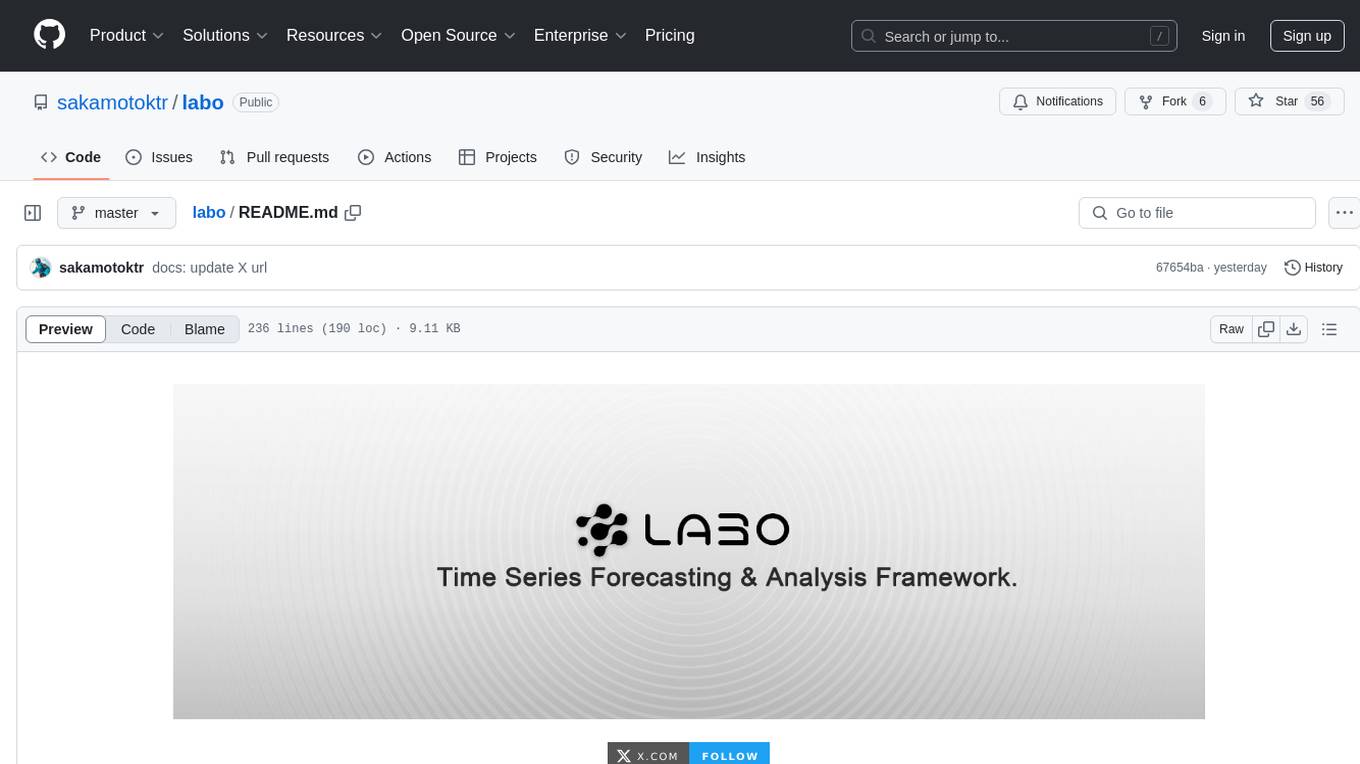
labo
LABO is a time series forecasting and analysis framework that integrates pre-trained and fine-tuned LLMs with multi-domain agent-based systems. It allows users to create and tune agents easily for various scenarios, such as stock market trend prediction and web public opinion analysis. LABO requires a specific runtime environment setup, including system requirements, Python environment, dependency installations, and configurations. Users can fine-tune their own models using LABO's Low-Rank Adaptation (LoRA) for computational efficiency and continuous model updates. Additionally, LABO provides a Python library for building model training pipelines and customizing agents for specific tasks.
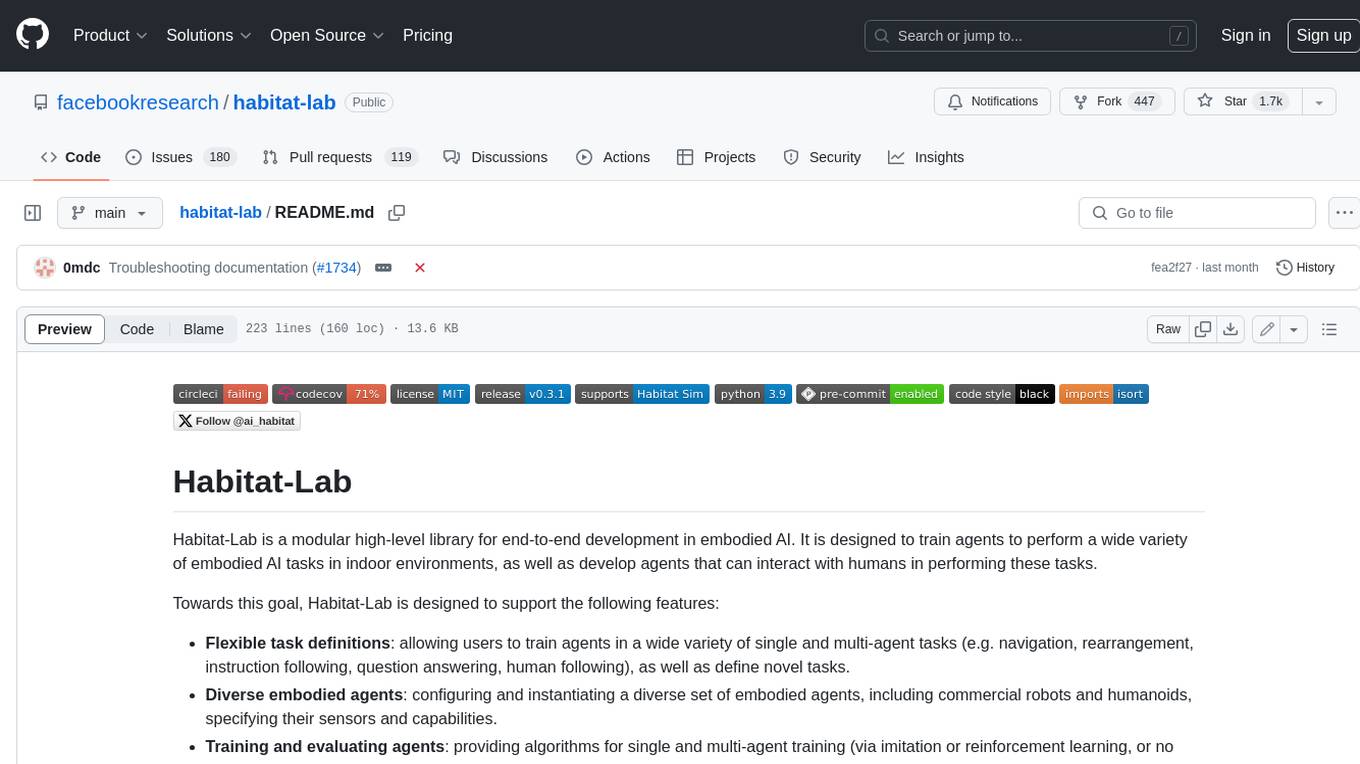
habitat-lab
Habitat-Lab is a modular high-level library for end-to-end development in embodied AI. It is designed to train agents to perform a wide variety of embodied AI tasks in indoor environments, as well as develop agents that can interact with humans in performing these tasks.
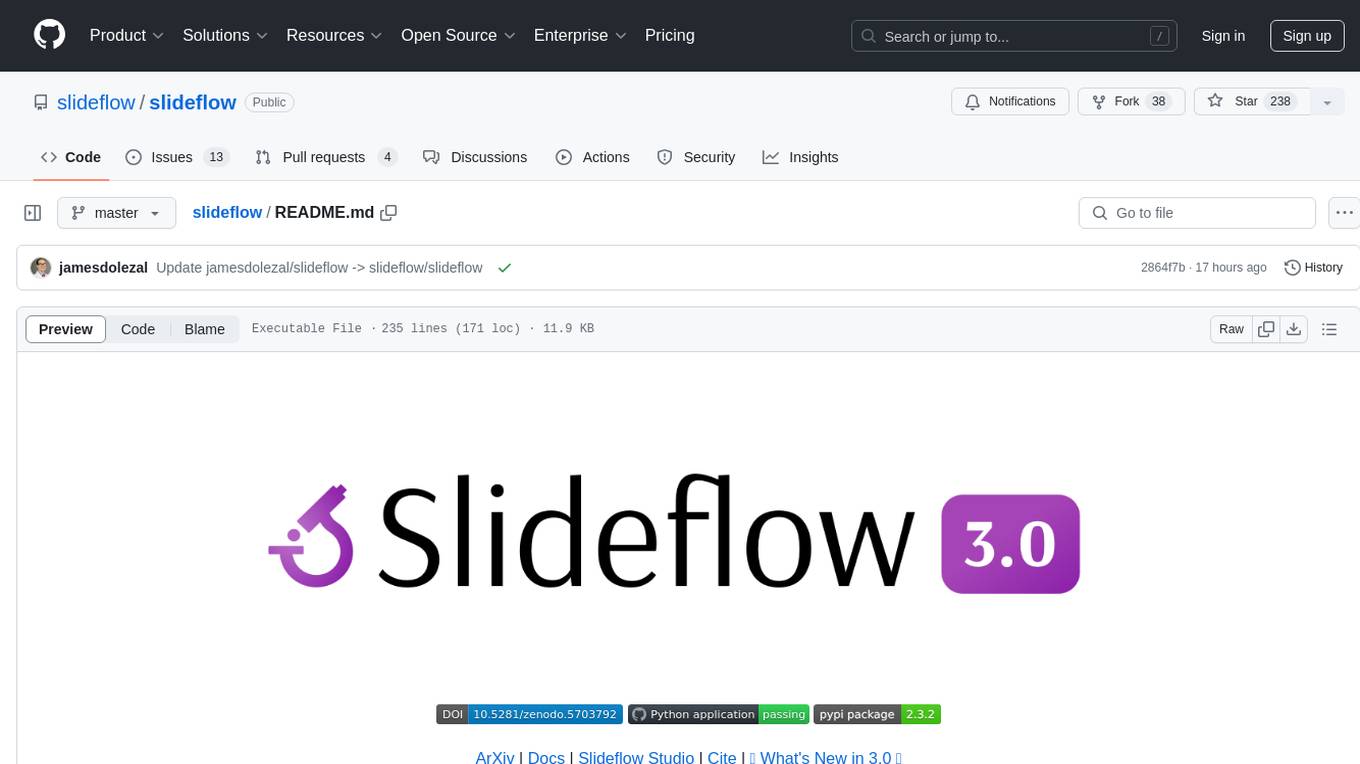
slideflow
Slideflow is a deep learning library for digital pathology, offering a user-friendly interface for model development. It is designed for medical researchers and AI enthusiasts, providing an accessible platform for developing state-of-the-art pathology models. Slideflow offers customizable training pipelines, robust slide processing and stain normalization toolkit, support for weakly-supervised or strongly-supervised labels, built-in foundation models, multiple-instance learning, self-supervised learning, generative adversarial networks, explainability tools, layer activation analysis tools, uncertainty quantification, interactive user interface for model deployment, and more. It supports both PyTorch and Tensorflow, with optional support for Libvips for slide reading. Slideflow can be installed via pip, Docker container, or from source, and includes non-commercial add-ons for additional tools and pretrained models. It allows users to create projects, extract tiles from slides, train models, and provides evaluation tools like heatmaps and mosaic maps.
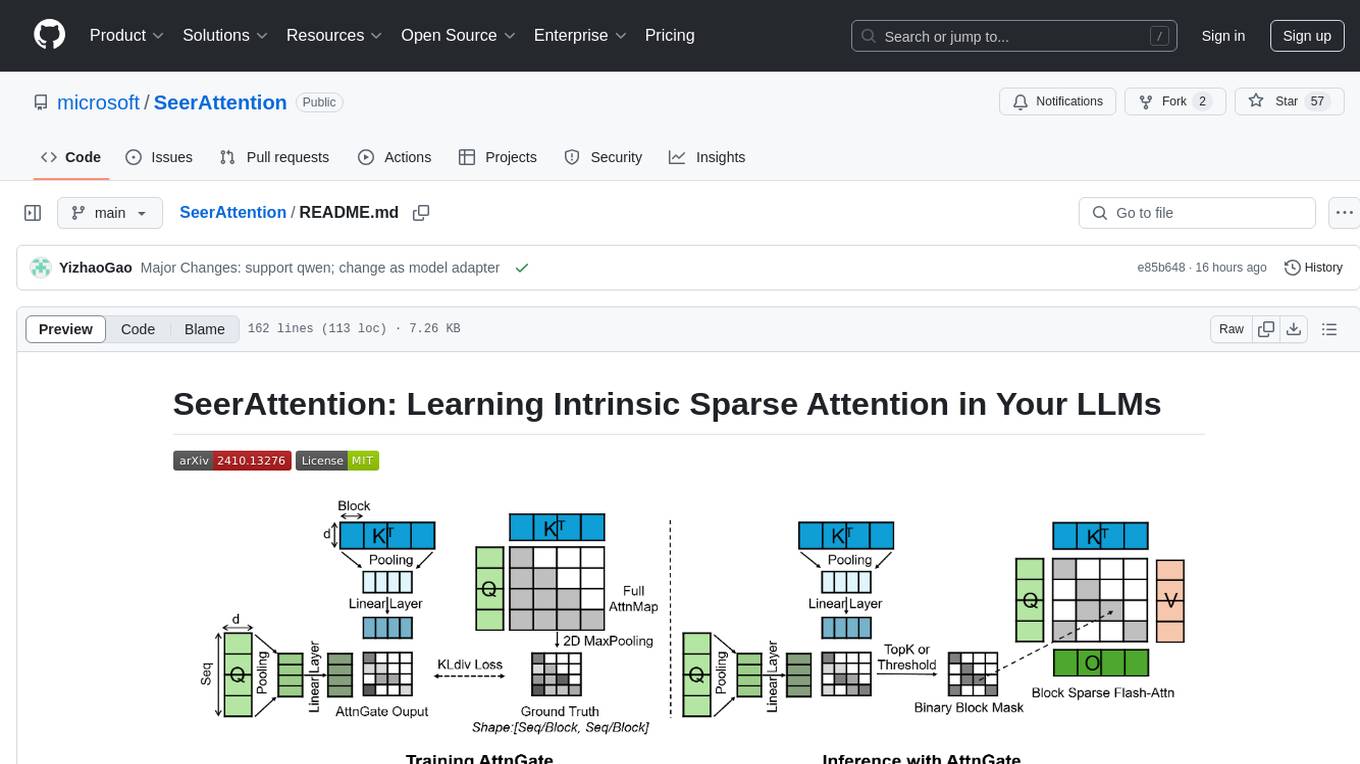
SeerAttention
SeerAttention is a novel trainable sparse attention mechanism that learns intrinsic sparsity patterns directly from LLMs through self-distillation at post-training time. It achieves faster inference while maintaining accuracy for long-context prefilling. The tool offers features such as trainable sparse attention, block-level sparsity, self-distillation, efficient kernel, and easy integration with existing transformer architectures. Users can quickly start using SeerAttention for inference with AttnGate Adapter and training attention gates with self-distillation. The tool provides efficient evaluation methods and encourages contributions from the community.
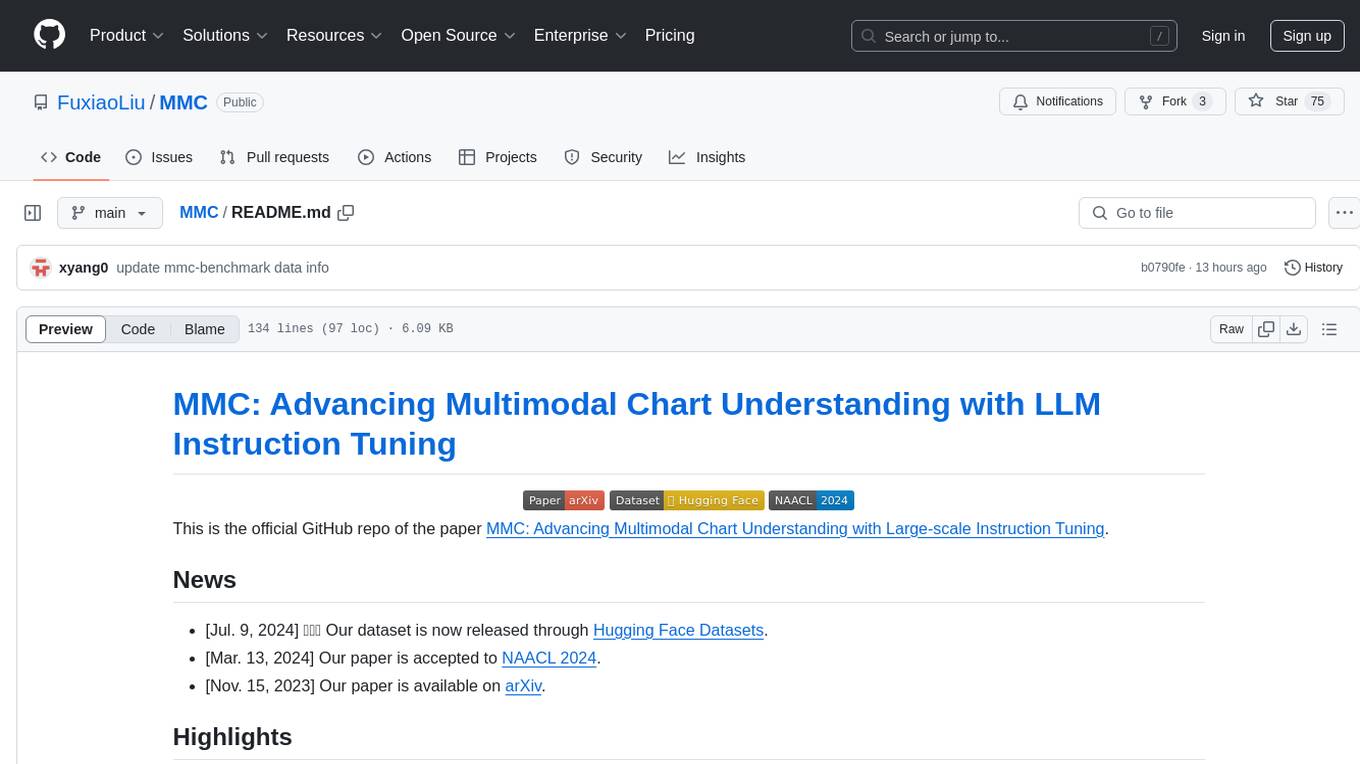
MMC
This repository, MMC, focuses on advancing multimodal chart understanding through large-scale instruction tuning. It introduces a dataset supporting various tasks and chart types, a benchmark for evaluating reasoning capabilities over charts, and an assistant achieving state-of-the-art performance on chart QA benchmarks. The repository provides data for chart-text alignment, benchmarking, and instruction tuning, along with existing datasets used in experiments. Additionally, it offers a Gradio demo for the MMCA model.
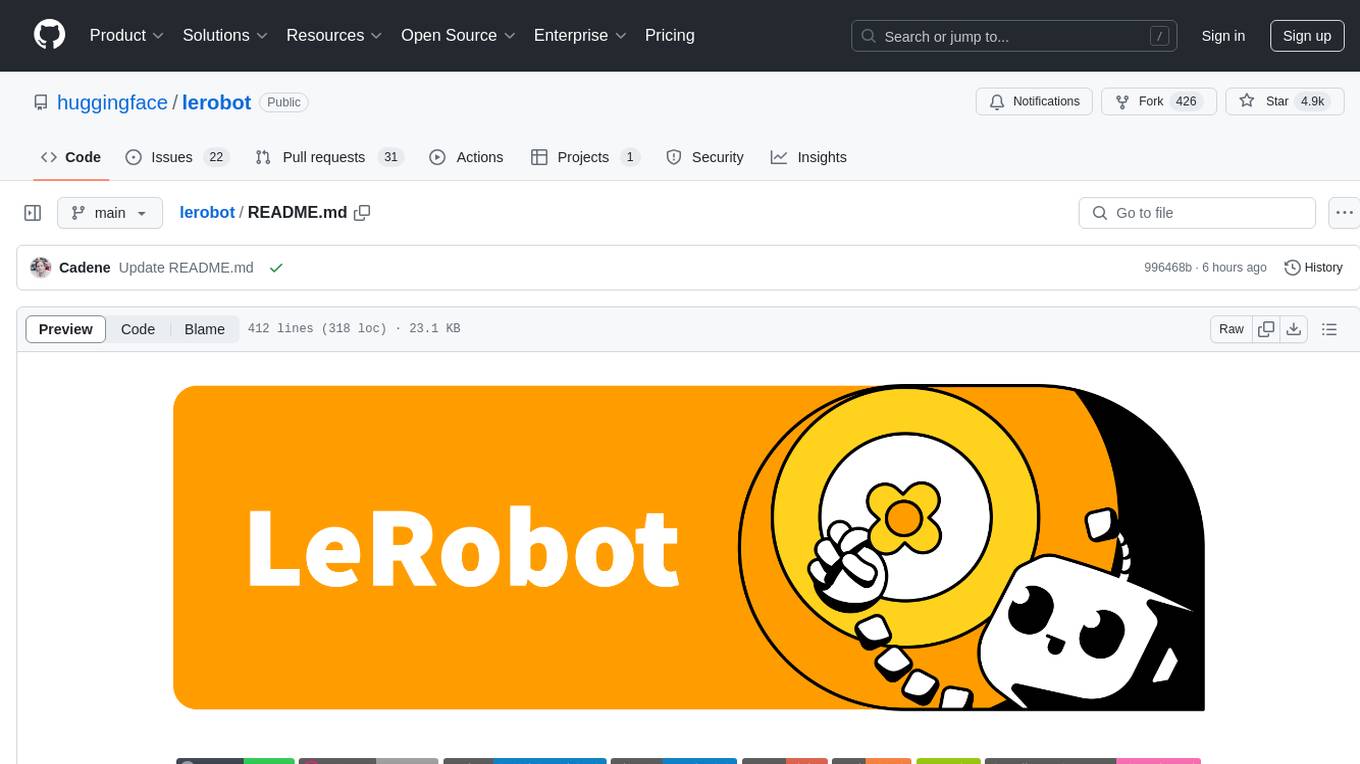
lerobot
LeRobot is a state-of-the-art AI library for real-world robotics in PyTorch. It aims to provide models, datasets, and tools to lower the barrier to entry to robotics, focusing on imitation learning and reinforcement learning. LeRobot offers pretrained models, datasets with human-collected demonstrations, and simulation environments. It plans to support real-world robotics on affordable and capable robots. The library hosts pretrained models and datasets on the Hugging Face community page.
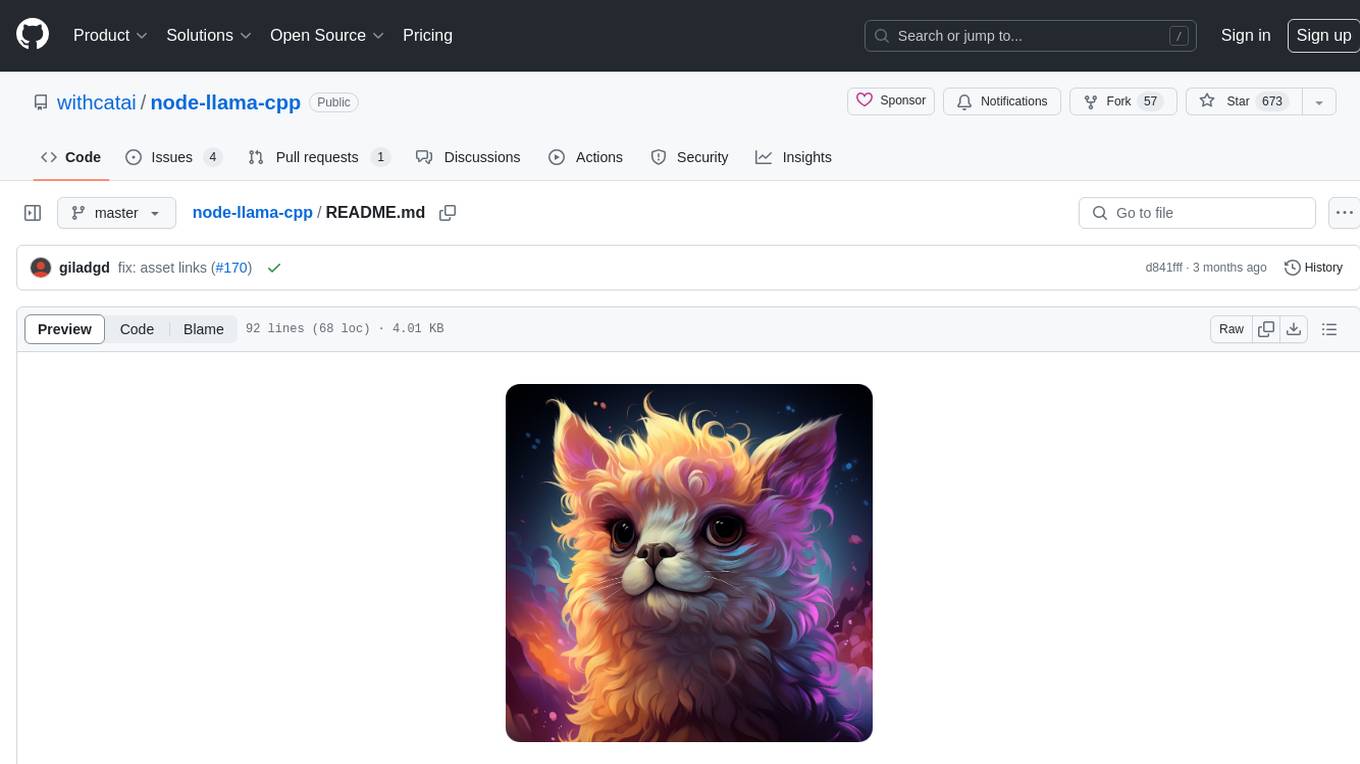
node-llama-cpp
node-llama-cpp is a tool that allows users to run AI models locally on their machines. It provides pre-built bindings with the option to build from source using cmake. Users can interact with text generation models, chat with models using a chat wrapper, and force models to generate output in a parseable format like JSON. The tool supports Metal and CUDA, offers CLI functionality for chatting with models without coding, and ensures up-to-date compatibility with the latest version of llama.cpp. Installation includes pre-built binaries for macOS, Linux, and Windows, with the option to build from source if binaries are not available for the platform.
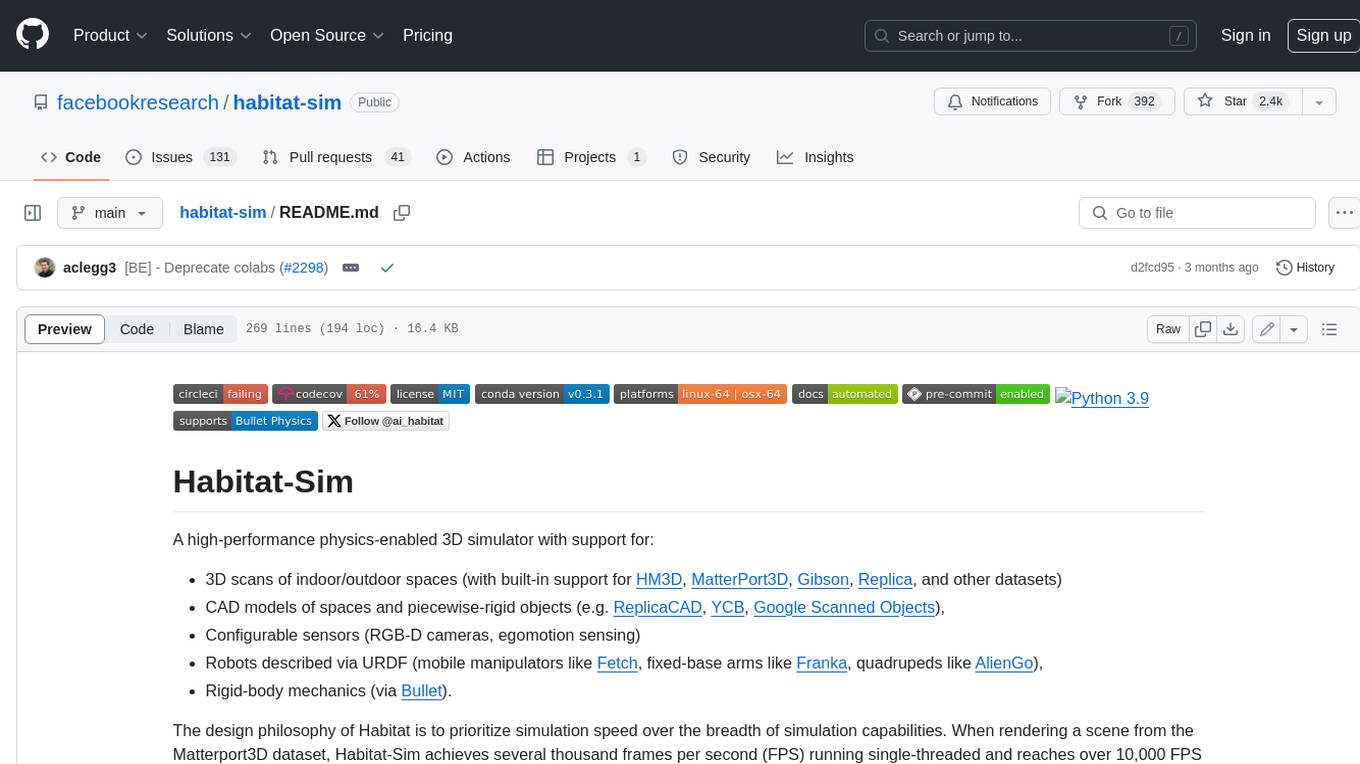
habitat-sim
Habitat-Sim is a high-performance physics-enabled 3D simulator with support for 3D scans of indoor/outdoor spaces, CAD models of spaces and piecewise-rigid objects, configurable sensors, robots described via URDF, and rigid-body mechanics. It prioritizes simulation speed over the breadth of simulation capabilities, achieving several thousand frames per second (FPS) running single-threaded and over 10,000 FPS multi-process on a single GPU when rendering a scene from the Matterport3D dataset. Habitat-Sim simulates a Fetch robot interacting in ReplicaCAD scenes at over 8,000 steps per second (SPS), where each ‘step’ involves rendering 1 RGBD observation (128×128 pixels) and rigid-body dynamics for 1/30sec.
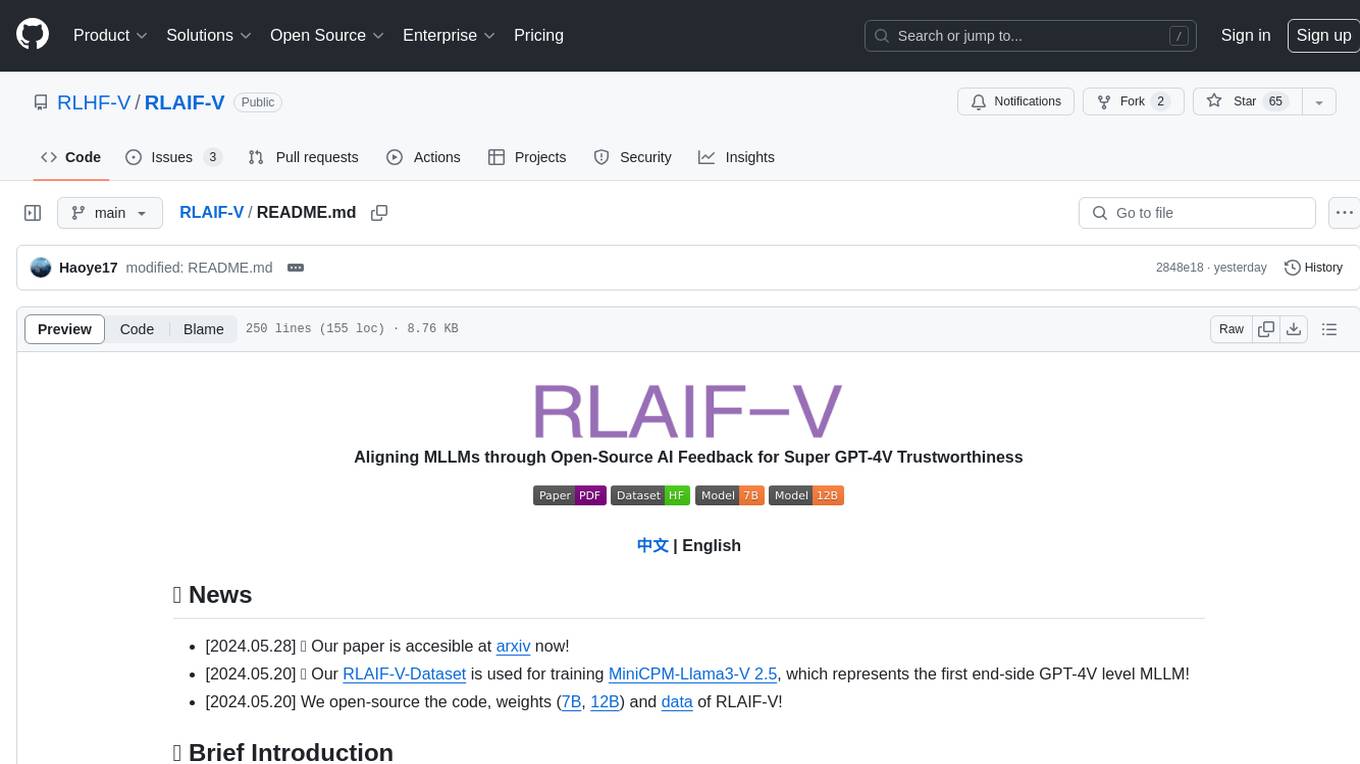
RLAIF-V
RLAIF-V is a novel framework that aligns MLLMs in a fully open-source paradigm for super GPT-4V trustworthiness. It maximally exploits open-source feedback from high-quality feedback data and online feedback learning algorithm. Notable features include achieving super GPT-4V trustworthiness in both generative and discriminative tasks, using high-quality generalizable feedback data to reduce hallucination of different MLLMs, and exhibiting better learning efficiency and higher performance through iterative alignment.
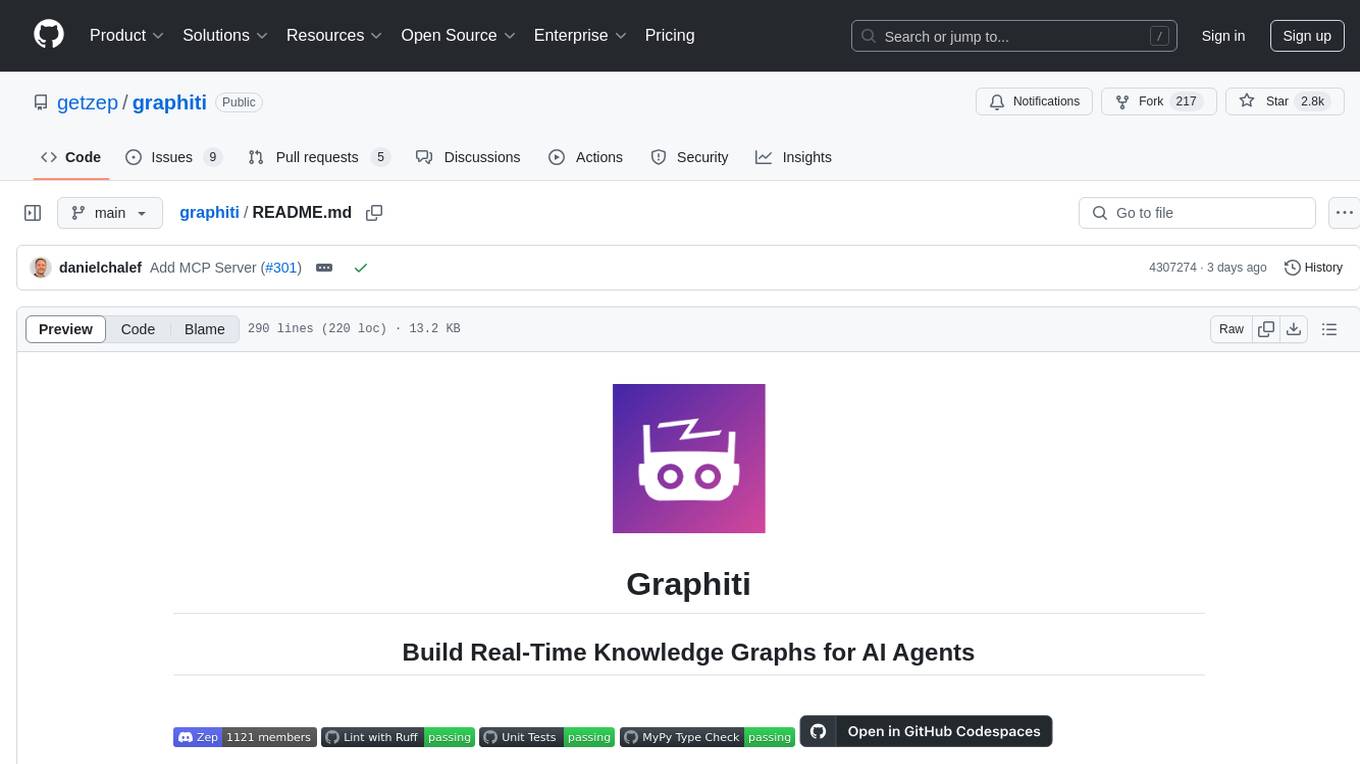
graphiti
Graphiti is a framework for building and querying temporally-aware knowledge graphs, tailored for AI agents in dynamic environments. It continuously integrates user interactions, structured and unstructured data, and external information into a coherent, queryable graph. The framework supports incremental data updates, efficient retrieval, and precise historical queries without complete graph recomputation, making it suitable for developing interactive, context-aware AI applications.

HolmesVAD
Holmes-VAD is a framework for unbiased and explainable Video Anomaly Detection using multimodal instructions. It addresses biased detection in challenging events by leveraging precise temporal supervision and rich multimodal instructions. The framework includes a largescale VAD instruction-tuning benchmark, VAD-Instruct50k, created with single-frame annotations and a robust video captioner. It offers accurate anomaly localization and comprehensive explanations through a customized solution for interpretable video anomaly detection.
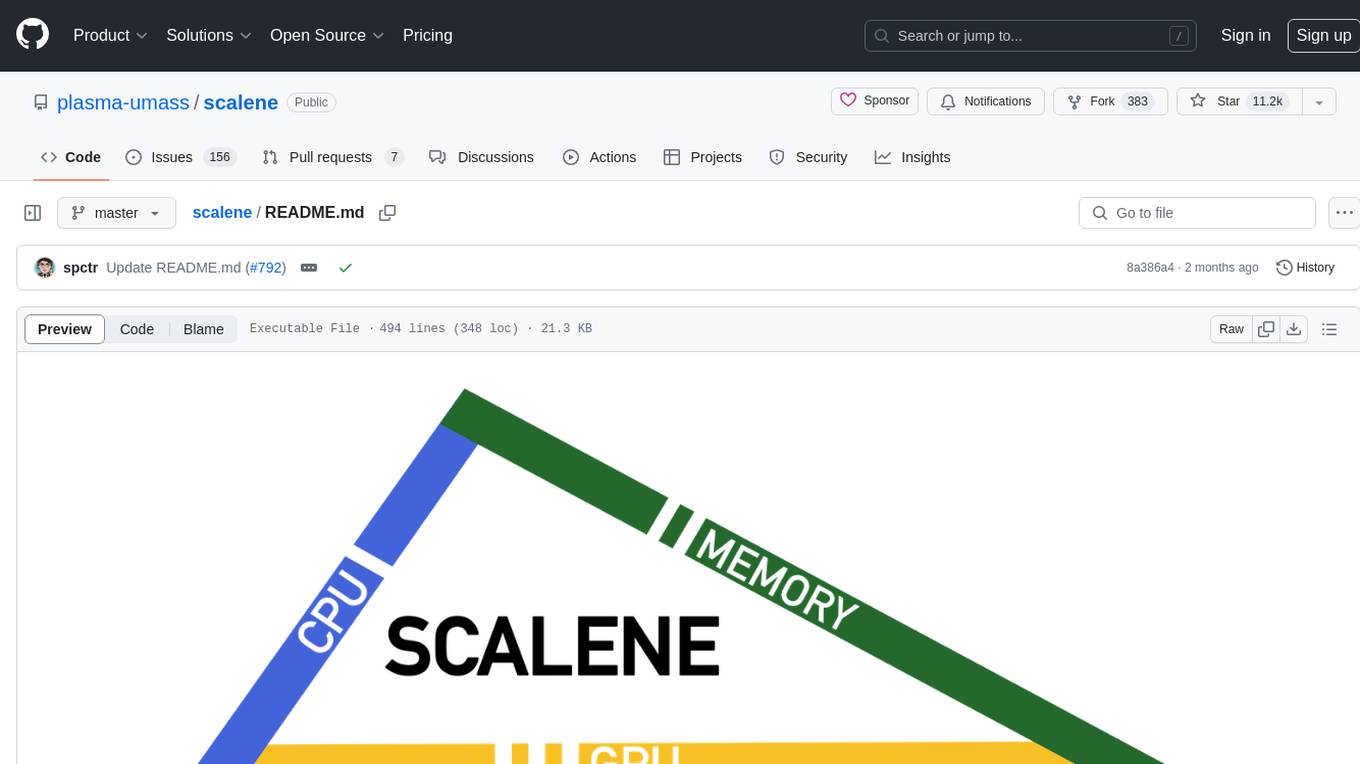
scalene
Scalene is a high-performance CPU, GPU, and memory profiler for Python that provides detailed information and runs faster than many other profilers. It incorporates AI-powered proposed optimizations, allowing users to generate optimization suggestions by clicking on specific lines or regions of code. Scalene separates time spent in Python from native code, highlights hotspots, and identifies memory usage per line. It supports GPU profiling on NVIDIA-based systems and detects memory leaks. Users can generate reduced profiles, profile specific functions using decorators, and suspend/resume profiling for background processes. Scalene is available as a pip or conda package and works on various platforms. It offers features like profiling at the line level, memory trends, copy volume reporting, and leak detection.
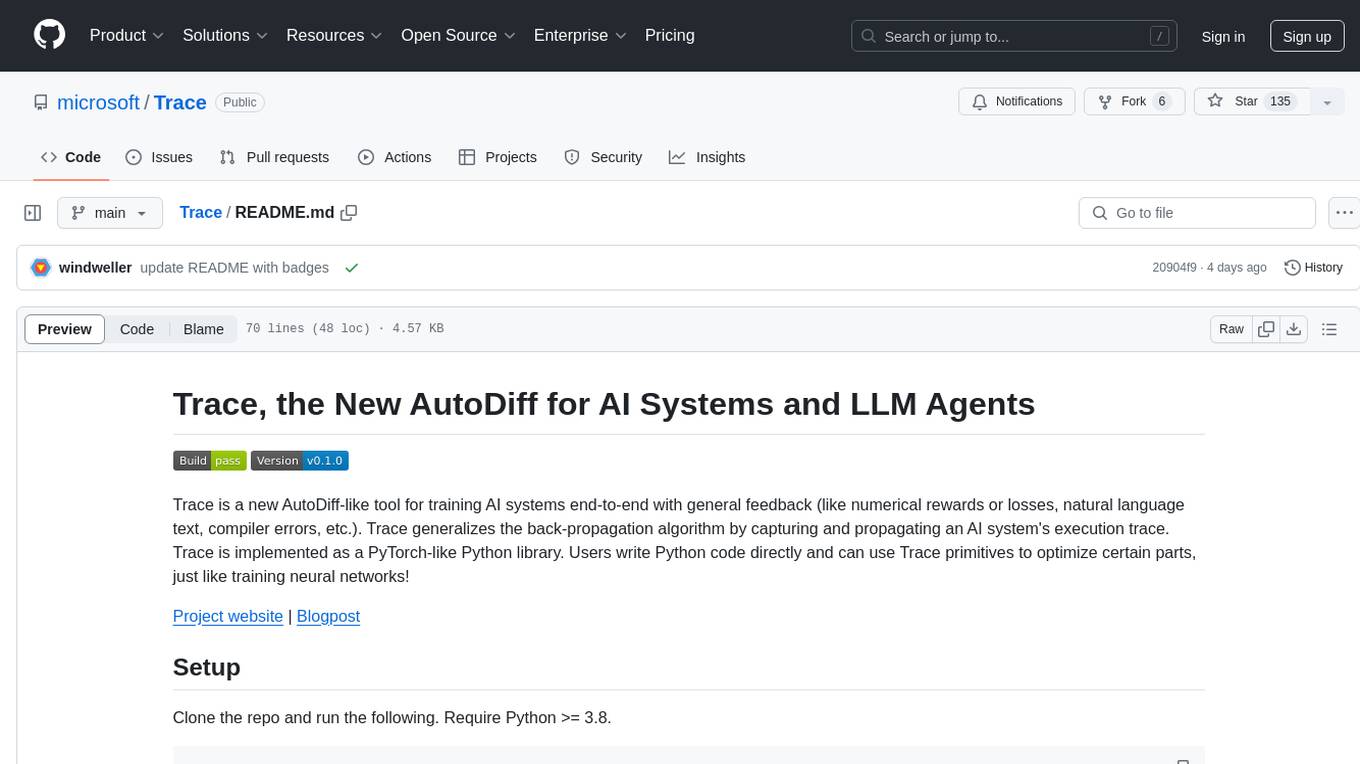
Trace
Trace is a new AutoDiff-like tool for training AI systems end-to-end with general feedback. It generalizes the back-propagation algorithm by capturing and propagating an AI system's execution trace. Implemented as a PyTorch-like Python library, users can write Python code directly and use Trace primitives to optimize certain parts, similar to training neural networks.
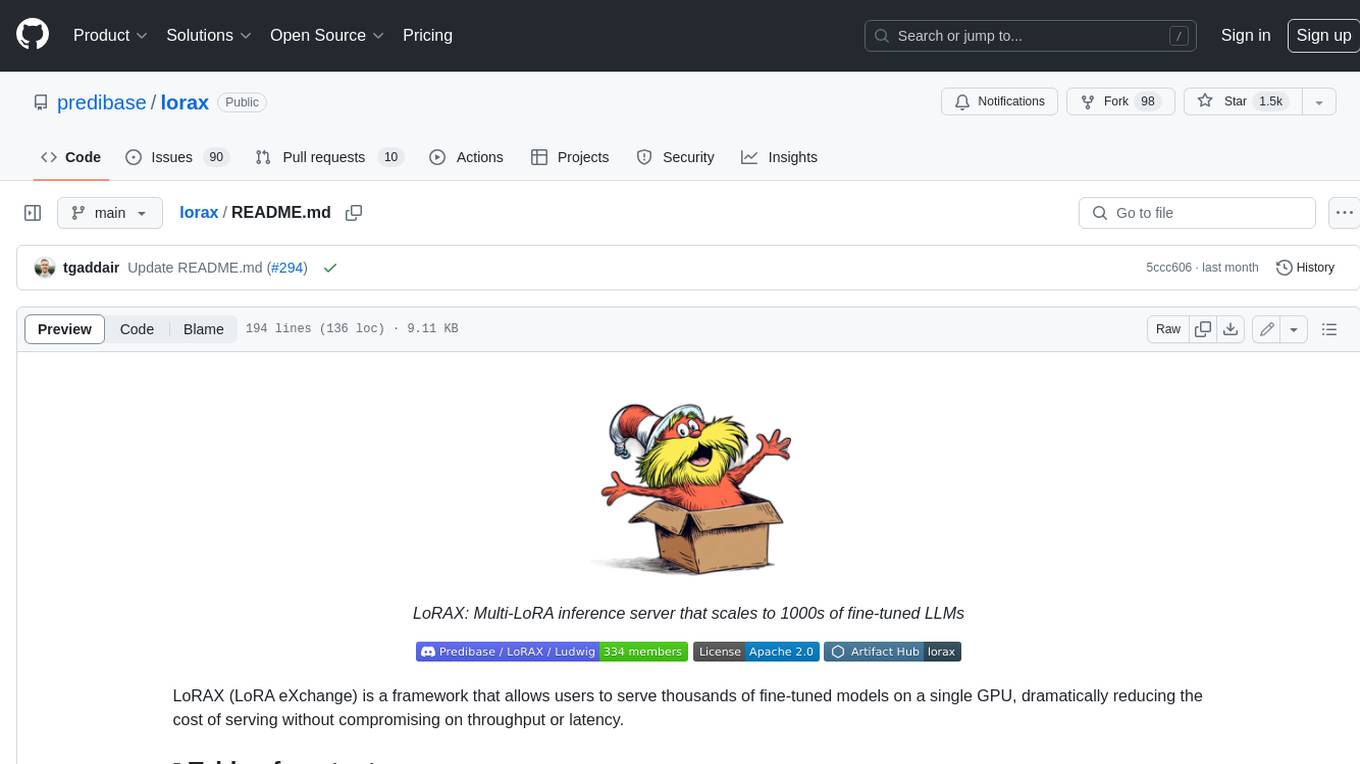
lorax
LoRAX is a framework that allows users to serve thousands of fine-tuned models on a single GPU, dramatically reducing the cost of serving without compromising on throughput or latency. It features dynamic adapter loading, heterogeneous continuous batching, adapter exchange scheduling, optimized inference, and is ready for production with prebuilt Docker images, Helm charts for Kubernetes, Prometheus metrics, and distributed tracing with Open Telemetry. LoRAX supports a number of Large Language Models as the base model including Llama, Mistral, and Qwen, and any of the linear layers in the model can be adapted via LoRA and loaded in LoRAX.
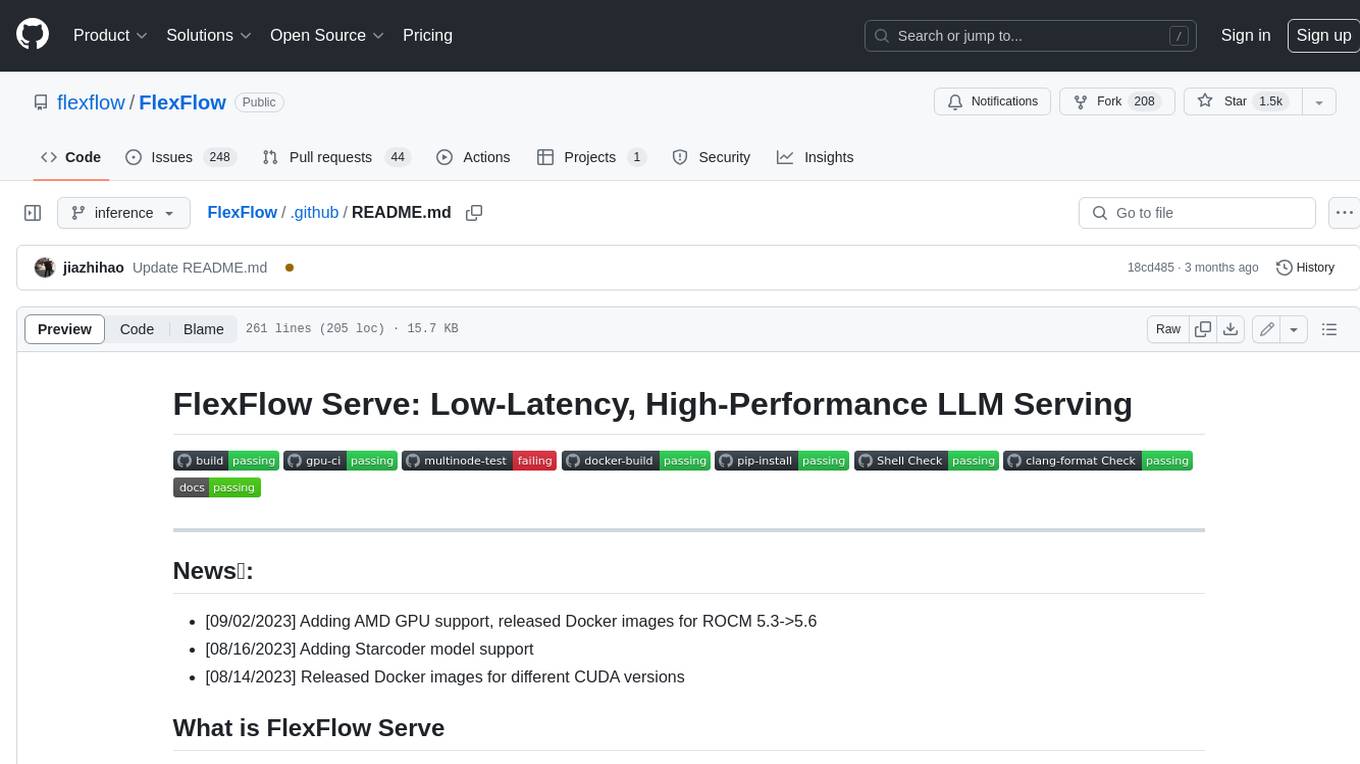
FlexFlow
FlexFlow Serve is an open-source compiler and distributed system for **low latency**, **high performance** LLM serving. FlexFlow Serve outperforms existing systems by 1.3-2.0x for single-node, multi-GPU inference and by 1.4-2.4x for multi-node, multi-GPU inference.
For similar tasks
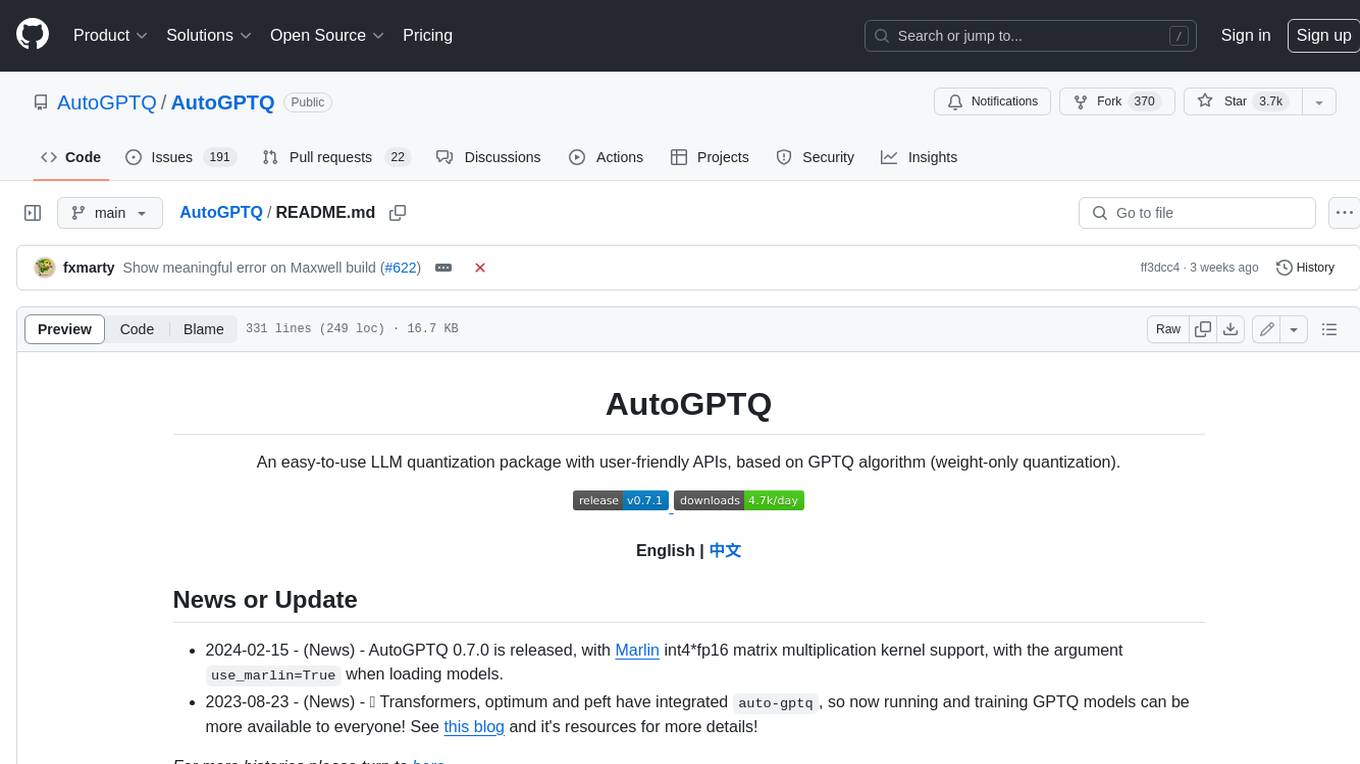
AutoGPTQ
AutoGPTQ is an easy-to-use LLM quantization package with user-friendly APIs, based on GPTQ algorithm (weight-only quantization). It provides a simple and efficient way to quantize large language models (LLMs) to reduce their size and computational cost while maintaining their performance. AutoGPTQ supports a wide range of LLM models, including GPT-2, GPT-J, OPT, and BLOOM. It also supports various evaluation tasks, such as language modeling, sequence classification, and text summarization. With AutoGPTQ, users can easily quantize their LLM models and deploy them on resource-constrained devices, such as mobile phones and embedded systems.
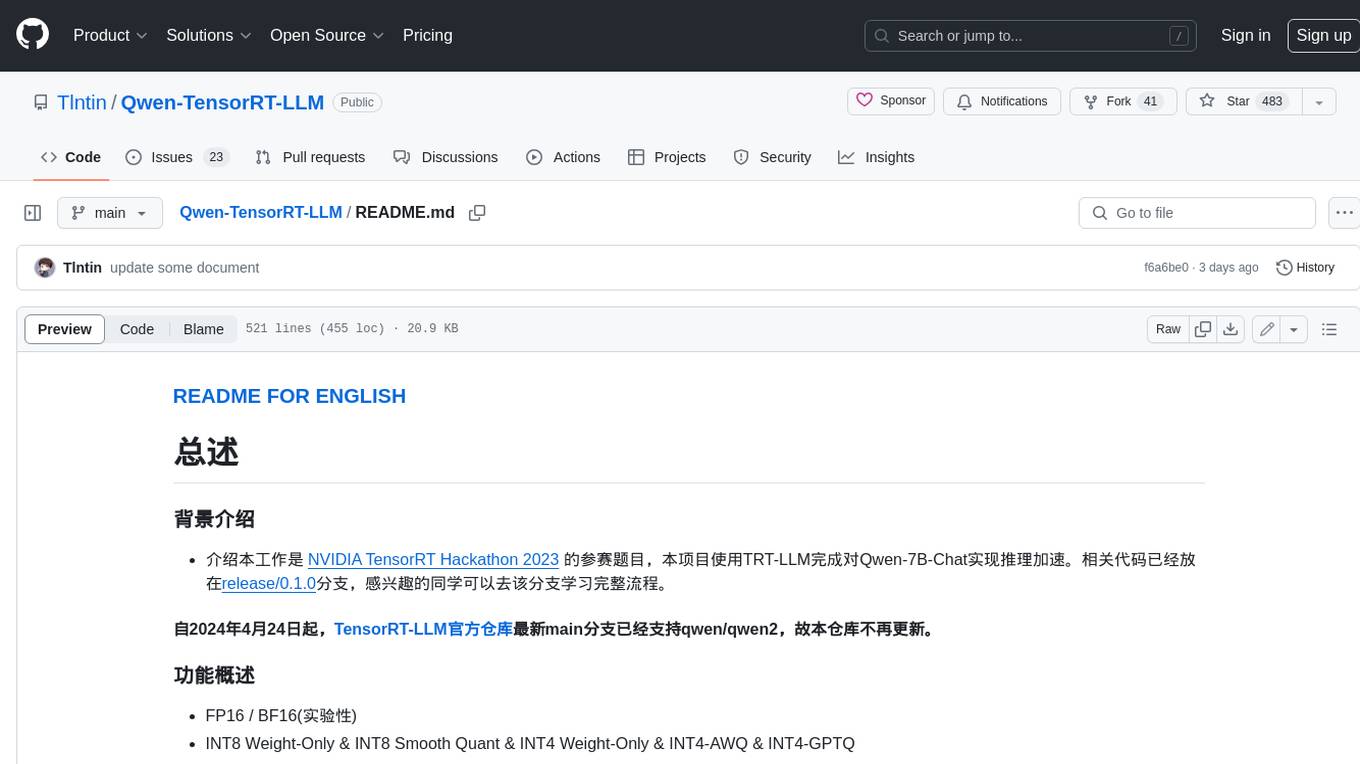
Qwen-TensorRT-LLM
Qwen-TensorRT-LLM is a project developed for the NVIDIA TensorRT Hackathon 2023, focusing on accelerating inference for the Qwen-7B-Chat model using TRT-LLM. The project offers various functionalities such as FP16/BF16 support, INT8 and INT4 quantization options, Tensor Parallel for multi-GPU parallelism, web demo setup with gradio, Triton API deployment for maximum throughput/concurrency, fastapi integration for openai requests, CLI interaction, and langchain support. It supports models like qwen2, qwen, and qwen-vl for both base and chat models. The project also provides tutorials on Bilibili and blogs for adapting Qwen models in NVIDIA TensorRT-LLM, along with hardware requirements and quick start guides for different model types and quantization methods.
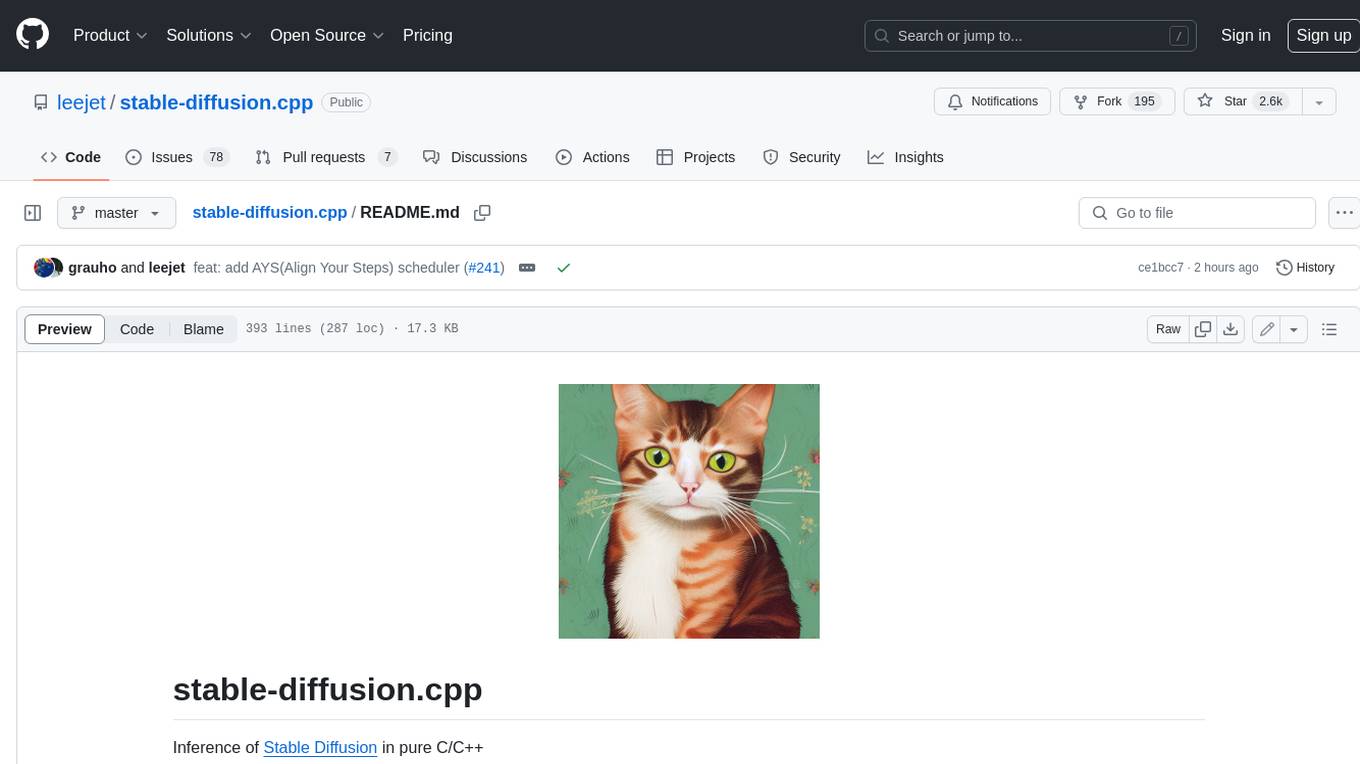
stable-diffusion.cpp
The stable-diffusion.cpp repository provides an implementation for inferring stable diffusion in pure C/C++. It offers features such as support for different versions of stable diffusion, lightweight and dependency-free implementation, various quantization support, memory-efficient CPU inference, GPU acceleration, and more. Users can download the built executable program or build it manually. The repository also includes instructions for downloading weights, building from scratch, using different acceleration methods, running the tool, converting weights, and utilizing various features like Flash Attention, ESRGAN upscaling, PhotoMaker support, and more. Additionally, it mentions future TODOs and provides information on memory requirements, bindings, UIs, contributors, and references.

LMOps
LMOps is a research initiative focusing on fundamental research and technology for building AI products with foundation models, particularly enabling AI capabilities with Large Language Models (LLMs) and Generative AI models. The project explores various aspects such as prompt optimization, longer context handling, LLM alignment, acceleration of LLMs, LLM customization, and understanding in-context learning. It also includes tools like Promptist for automatic prompt optimization, Structured Prompting for efficient long-sequence prompts consumption, and X-Prompt for extensible prompts beyond natural language. Additionally, LLMA accelerators are developed to speed up LLM inference by referencing and copying text spans from documents. The project aims to advance technologies that facilitate prompting language models and enhance the performance of LLMs in various scenarios.
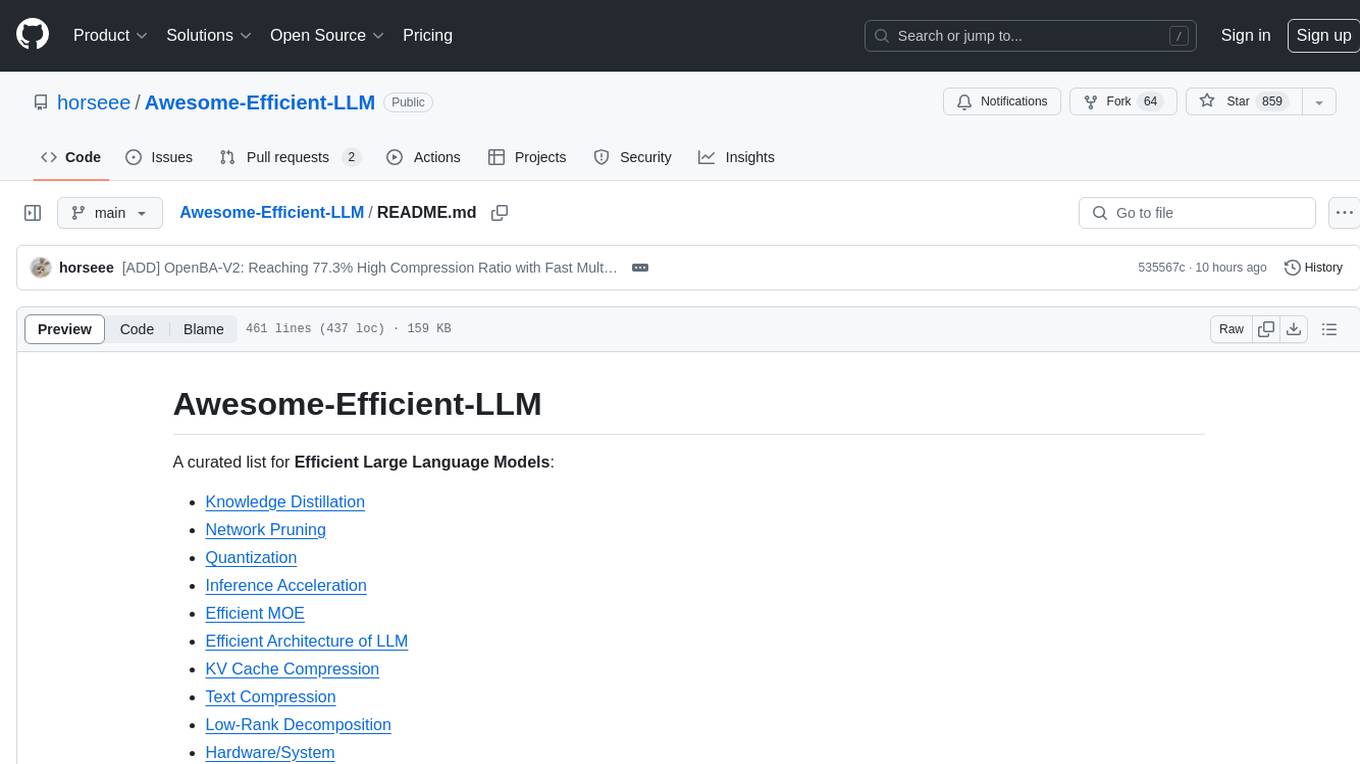
Awesome-Efficient-LLM
Awesome-Efficient-LLM is a curated list focusing on efficient large language models. It includes topics such as knowledge distillation, network pruning, quantization, inference acceleration, efficient MOE, efficient architecture of LLM, KV cache compression, text compression, low-rank decomposition, hardware/system, tuning, and survey. The repository provides a collection of papers and projects related to improving the efficiency of large language models through various techniques like sparsity, quantization, and compression.
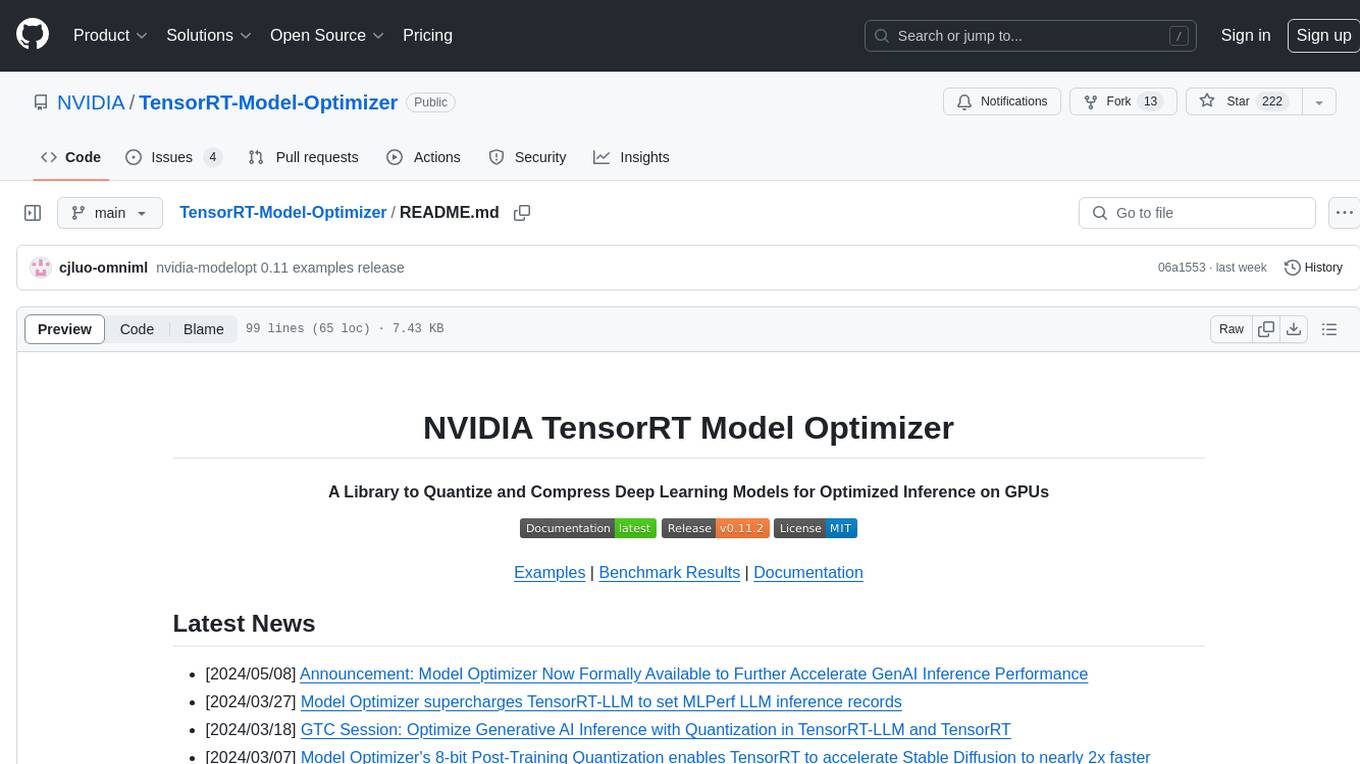
TensorRT-Model-Optimizer
The NVIDIA TensorRT Model Optimizer is a library designed to quantize and compress deep learning models for optimized inference on GPUs. It offers state-of-the-art model optimization techniques including quantization and sparsity to reduce inference costs for generative AI models. Users can easily stack different optimization techniques to produce quantized checkpoints from torch or ONNX models. The quantized checkpoints are ready for deployment in inference frameworks like TensorRT-LLM or TensorRT, with planned integrations for NVIDIA NeMo and Megatron-LM. The tool also supports 8-bit quantization with Stable Diffusion for enterprise users on NVIDIA NIM. Model Optimizer is available for free on NVIDIA PyPI, and this repository serves as a platform for sharing examples, GPU-optimized recipes, and collecting community feedback.
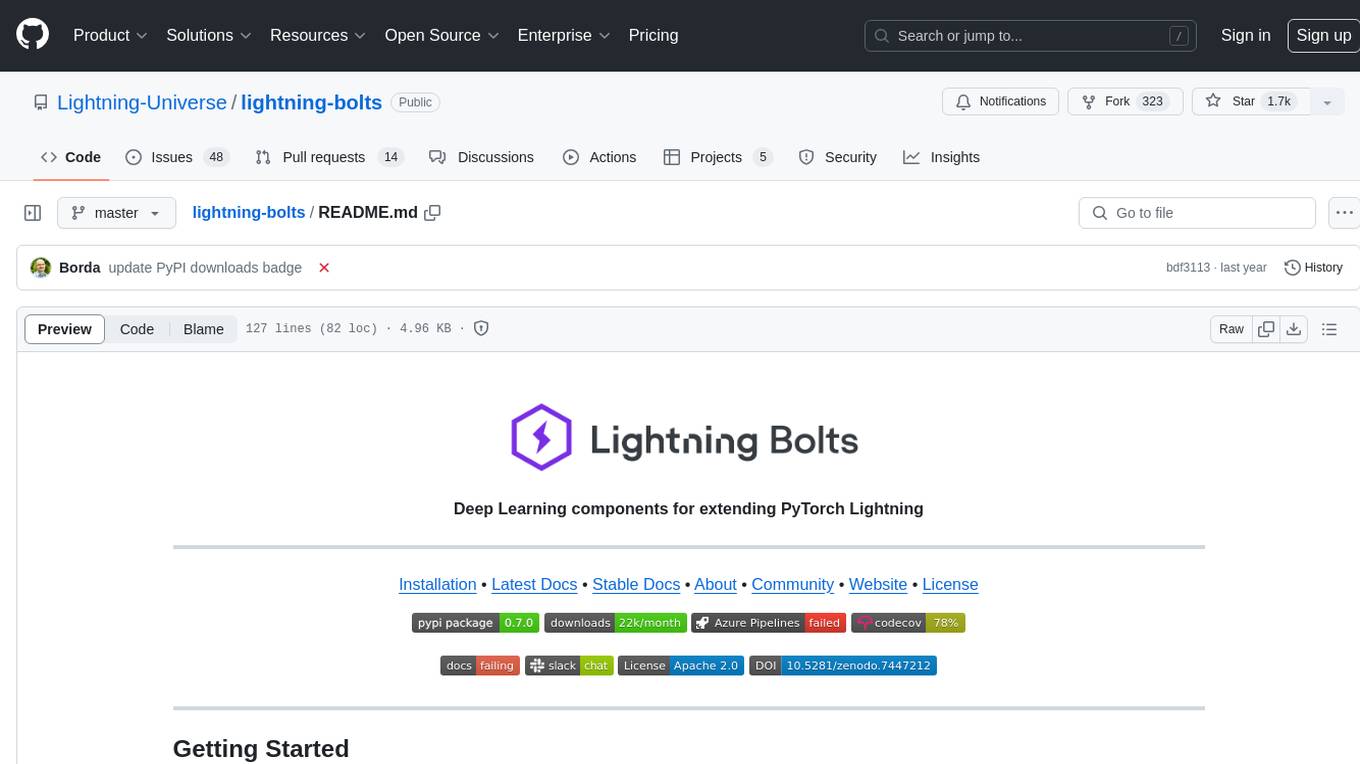
lightning-bolts
Bolts package provides a variety of components to extend PyTorch Lightning, such as callbacks & datasets, for applied research and production. Users can accelerate Lightning training with the Torch ORT Callback to optimize ONNX graph for faster training & inference. Additionally, users can introduce sparsity with the SparseMLCallback to accelerate inference by leveraging the DeepSparse engine. Specific research implementations are encouraged, with contributions that help train SSL models and integrate with Lightning Flash for state-of-the-art models in applied research.
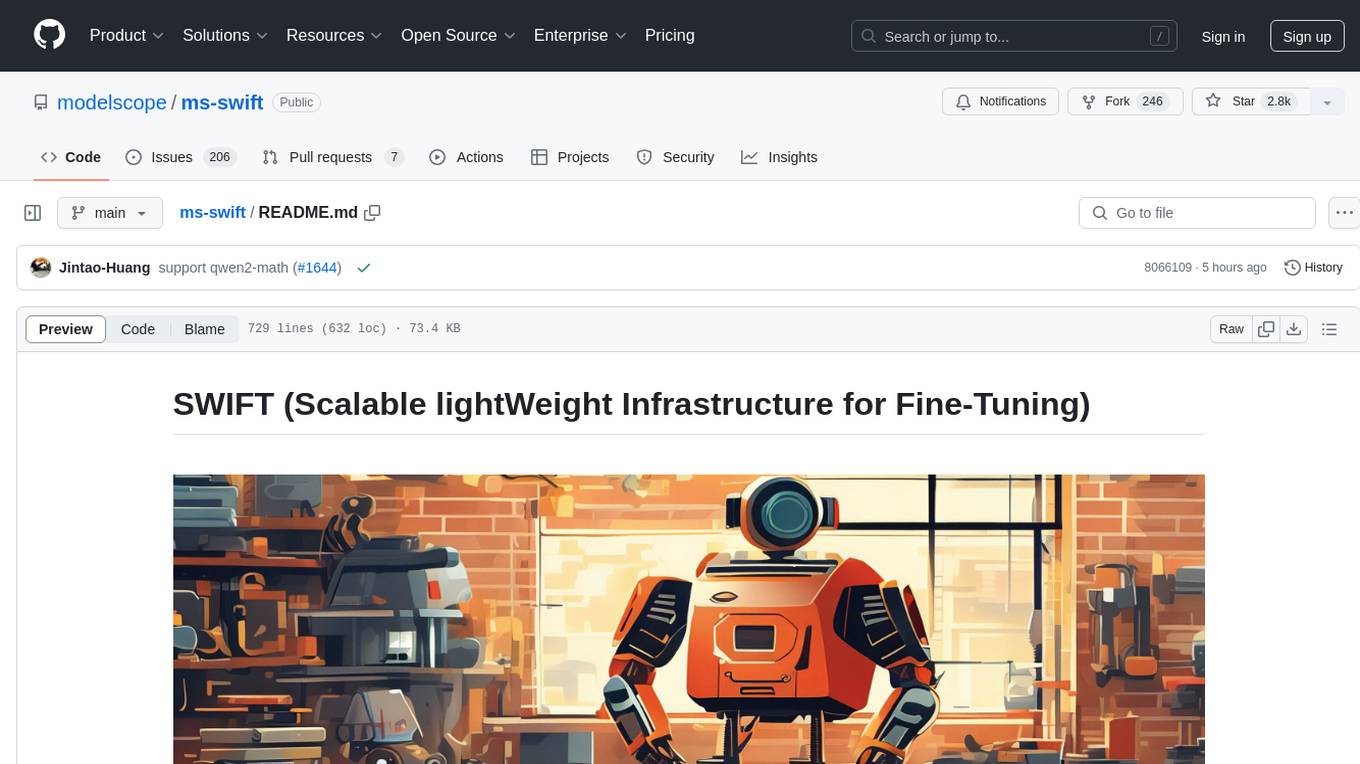
ms-swift
ms-swift is an official framework provided by the ModelScope community for fine-tuning and deploying large language models and multi-modal large models. It supports training, inference, evaluation, quantization, and deployment of over 400 large models and 100+ multi-modal large models. The framework includes various training technologies and accelerates inference, evaluation, and deployment modules. It offers a Gradio-based Web-UI interface and best practices for easy application of large models. ms-swift supports a wide range of model types, dataset types, hardware support, lightweight training methods, distributed training techniques, quantization training, RLHF training, multi-modal training, interface training, plugin and extension support, inference acceleration engines, model evaluation, and model quantization.
For similar jobs

sweep
Sweep is an AI junior developer that turns bugs and feature requests into code changes. It automatically handles developer experience improvements like adding type hints and improving test coverage.

teams-ai
The Teams AI Library is a software development kit (SDK) that helps developers create bots that can interact with Teams and Microsoft 365 applications. It is built on top of the Bot Framework SDK and simplifies the process of developing bots that interact with Teams' artificial intelligence capabilities. The SDK is available for JavaScript/TypeScript, .NET, and Python.

ai-guide
This guide is dedicated to Large Language Models (LLMs) that you can run on your home computer. It assumes your PC is a lower-end, non-gaming setup.

classifai
Supercharge WordPress Content Workflows and Engagement with Artificial Intelligence. Tap into leading cloud-based services like OpenAI, Microsoft Azure AI, Google Gemini and IBM Watson to augment your WordPress-powered websites. Publish content faster while improving SEO performance and increasing audience engagement. ClassifAI integrates Artificial Intelligence and Machine Learning technologies to lighten your workload and eliminate tedious tasks, giving you more time to create original content that matters.

chatbot-ui
Chatbot UI is an open-source AI chat app that allows users to create and deploy their own AI chatbots. It is easy to use and can be customized to fit any need. Chatbot UI is perfect for businesses, developers, and anyone who wants to create a chatbot.

BricksLLM
BricksLLM is a cloud native AI gateway written in Go. Currently, it provides native support for OpenAI, Anthropic, Azure OpenAI and vLLM. BricksLLM aims to provide enterprise level infrastructure that can power any LLM production use cases. Here are some use cases for BricksLLM: * Set LLM usage limits for users on different pricing tiers * Track LLM usage on a per user and per organization basis * Block or redact requests containing PIIs * Improve LLM reliability with failovers, retries and caching * Distribute API keys with rate limits and cost limits for internal development/production use cases * Distribute API keys with rate limits and cost limits for students

uAgents
uAgents is a Python library developed by Fetch.ai that allows for the creation of autonomous AI agents. These agents can perform various tasks on a schedule or take action on various events. uAgents are easy to create and manage, and they are connected to a fast-growing network of other uAgents. They are also secure, with cryptographically secured messages and wallets.

griptape
Griptape is a modular Python framework for building AI-powered applications that securely connect to your enterprise data and APIs. It offers developers the ability to maintain control and flexibility at every step. Griptape's core components include Structures (Agents, Pipelines, and Workflows), Tasks, Tools, Memory (Conversation Memory, Task Memory, and Meta Memory), Drivers (Prompt and Embedding Drivers, Vector Store Drivers, Image Generation Drivers, Image Query Drivers, SQL Drivers, Web Scraper Drivers, and Conversation Memory Drivers), Engines (Query Engines, Extraction Engines, Summary Engines, Image Generation Engines, and Image Query Engines), and additional components (Rulesets, Loaders, Artifacts, Chunkers, and Tokenizers). Griptape enables developers to create AI-powered applications with ease and efficiency.







